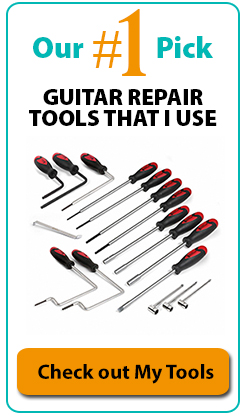There are many different styles of electric guitar fretboards, frets, and necks. Each style of electric guitar will have a slightly different process for fretting the neck. Obviously before you fret an electric guitar, you will need to remove the frets in the fretboard. For instructions on how to remove electric guitar frets, see the electric guitar fret removal page.
Fretting an Electric Guitar with a Unbound Fretboard
Contents
As I discussed on the fretboard binding page and the fret removal page, fretboards can have binding around the edges. Fretboards without binding around the edges are easier and less time consuming to re-fret. You do not have to be worried about ruining or cutting into the fretboard binding. You also don’t have to nip the fret tangs off of the edges of the fret wire. Here are the steps to re-fretting an electric guitar with an unbound fretboard.
Clean the Fret Slots
After the frets have been removed from the fretboard, you will need to clean the frets slots. Take a fret slot saw and lightly saw out the glue that is left in the fret slot. You may use the same style of fret slot saw that you use for a guitar with fretboard binding or you may use a regular straight saw, as you don’t have to worry about cutting through the binding. As I said, lightly saw out the dried glue. You don’t want to make the slot any deeper; you just want to clean it out. Once you have cleaned the slot with the saw, you can take a curved X-acto knife and scrape out the sawdust. If the glue is extremely tough, you can use a dremel tool with a small .023″ bit to route out the excess dried glue.
Choosing Electric Guitar Fret Wire
Once you have the fret slots cleaned out, you will need to figure out what style of frets you want to install. Choosing electric guitar fret wire can be kind of complicated. If you are installing frets for the first time, you probably want to install the same style of frets that you just removed from your guitar. You may also want to change the fret wire that is on your guitar to better suit your playing style. Either way, you will need to know a little background on fret wire and what is the best size and style to use. I have written an entire article of choosing fret wire. Please see the how to choose electric guitar fret wire page for more details.
Bend the Fret Wire to the correct Radius
First, you will need to measure the radius of your fretboard. You can do this by taking a radius gauge and placing it on you fretboard. The correct radius gauge will sit flush on the top of the fretboard and not allow light through the gap between the gauge and the fretboard. Second, take a fret wire bender and bend the fret wire to a radius slightly tighter than the radius of the fretboard. If you make the radius of the frets a little tighter than the radius of the fretboard, the frets will be able to dig into the fret slots better. Run the fret wire through the fret wire bender and check the fret wire with the same radius gauge you used to check the radius of the fretboard. Slightly bend the fret wire with each pass through the fret wire bender until it has a slightly tighter radius than your fretboard. You don’t want to bend the fret wire too much. It is difficult to unbend. For more information about how to bend fret wire, please see the how to bend fret wire page.
Cut the Fret Wire
Using your end nippers, cut each piece of fret wire to about 1/4″ bigger than the fretboard where it is to be installed. You want the fret wire to have about 1/8″ extra on both sides of the fretboard when you install it. After you cut a piece of fret wire for a particular fret, label it. You want to cut the fret wire for specific frets. Each piece of fret wire will be a little different from the rest. I like to use a numbered fret block. Please see the example below (picture coming soon). I have drilled and numbered holes in a block of wood for the fret wire to sit in. The fret block helps me keep my custom fret wire in order easily.
Install the Frets
Now you are ready to install the frets on your guitar. For instructions on how to install the frets on your electric guitar, see the how to install frets on an electric guitar page.
Related articles:
- How to do common Fret Repairs on Electric Guitars
- How to Dress Electric Guitar Frets
- How to Remove Electric Guitar Frets
- How to Bend Electric Guitar Frets
- How to Fret and Electric Guitar
- How to Fret an Electric Guitar with a Bound Fretboard
- How to Fret an Electric Guitar with an Unbound Fretboard
- How to Fret a Maple Neck Guitar
- How to Repair Loose Fret Ends
- How to Choose Fret Wire
- How to Polish Guitar Frets
- Learn Guitar Online

